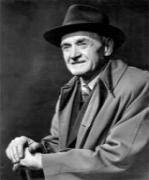|
|
||||||||||||||||||||||||
 |
Featured person
Recently added |
Samuel Crowe Curran (1912 - 1998): |
||||||||||||||||||||||
Samuel Crowe Curran was born in 1912 at Ballymena, County Antrim; although his mother had married and settled in Wishaw, Lanarkshire, she travelled back to her native Ulster expressly so that Samuel could be born there. Soon after his birth the family moved back to Wishaw, where he attended Wishaw High School (where he became "dux" or head boy), and enrolled at the University of Glasgow in 1929 where he graduated with first class honours in Mathematics and Physics. From 1934 he was a research student in the Physics department, where he completed a PhD in 1937. This involved a lot of work constructing Geiger counters, which prompted him to move to St John's College Cambridge to study for a further PhD at the Cavendish Laboratory, which was headed by Lord Rutherford and where he was able to work closely with CTR Wilson, Nobel Prize winner and inventor of the cloud chamber.
While at Cambridge, his supervisor suggested that Curran and a fellow PhD student, Joan Strothers, whom he later married, spend a month at the Royal Aircraft Establishment at Farnborough, where they arrived on 1st September, 1939. Curran and Strothers moved to Exeter, where they helped develop the proximity fuse, which played a vital part in air defence, including the shooting down of 90% of V1 rockets fired at southern England towards the end of the war.
In 1940 they transferred to The Telecommunications Research Establishment at Swanage, where Sir Bernard Lovell and others were already working on the development of centimetre radar, which allowed for the detection of much smaller objects and the use of much smaller antennas, basing this on the invention of a new type of wave generator, the magnetron; Curran's development of spark-plug modulators was critical to the functioning of magneton transmitters in airborne systems. This research led to the development of H25, a most significant tool in the successful pursuit of U-boats, vital to the war effort. (At the same time, Curran's wife had developed the idea of "windows", which consisted of dropping hundreds of metal strips in the path of enemy aircraft, which disrupted their radar.)
In 1944, Curran and his wife transferred to the Manhattan Project at the University of California at Berkeley, to work on the research and design of isotope electromagnetic separators, crucial for the development of a nuclear bomb. As part of this work, Curran invented the scintillation counter, a radiation detector which is still one of the most versatile particle detectors, and is widely used in industry, scientific research, medical diagnosis, and radiation monitoring, as well as in exploration for petroleum and radioactive minerals that emit gamma rays.
When the war ended, he returned to Scotland to a post in Natural Philosophy (that is, Physics) at Glasgow University, where he worked on the development of synchrotrons (particle accelerators) and in 1948 invented the proportional counter, a measurement device to count particles of ionising radiation and measure their energy. In 1955 he moved to the UK Atomic Energy Authority was Chief Scientist at the Atomic Weapons Research Establishment, Aldermaston, where a hydrogen bomb was being developed. But he later said that doubts about where this research would lead prompted him to seek another direction, and in 1959, he was appointed Principal of the Royal College of Science and Technology, Glasgow.
Curran planned to have this already world-renowned institution elevated to university status; he was described as the "dynamo" behind this. It was not uncontroversial. The University Grants Committee had reservations about creating any new university, let alone a specialist technological one, but by 1961 it was announced that the College would merge with the Scottish College of Commerce to become, in 1964, the University of Strathclyde, the first new university to be established in Scotland for nearly 400 years. Curran was its fist vice-chancellor. It displayed a number of innovations: student participation in management of the university was written into the Charter, and Curran encouraged links with industry, including figures from industry as visiting professors and encouraging members of staff to accept consultancies in industry; he appointed top industrialists to the University Court and built a Centre for Industrial Innovation, forerunner of the "science parks". He remained as Vice-Chancellor until 1980.
Curran served on numerous boards and committees, including the Science Research Council, the Advisory Council on Technology, the Advisory Committee on Medical Research (of which he was Chairman), the Advisory Committee on the Safety of Nuclear Installations, and was Chief Scientific Advisor to the Secretary of State for Scotland. Outside his professional work he and his wife set up the Scottish Association of Parents of Handicapped Children, subsequently known as "Enable", serving as its president from 1964 to 1991. The organisation's office and leisure facilities were named Curran House after them.
His numerous publications reflected his scientific and educational work, and he received a number of honorary degrees: from the Universities of Glasgow, Strathclyde, Nova Scotia and Lodz, with which university he had established close academic links while at Strathclyde. He was a Fellow of the Royal Society of Edinburgh, a Fellow of the Royal Society (London) and was knighted in 1970. He also was a Commander of the Order of St Olav, Norway, and a Commander of the Order of the Polish People's Republic. The Curran Building at the University of Strathclyde, which houses the Library, is named for him.
| Born: | 23 May 1912 |
| Died: | 15 February 1998 |
| Richard Froggatt |
| Acknowledgements: Wesley McCann |


Home | Our Policies | Plaques | Browse | Search | Sponsors | Links | Help | Contact
Privacy & Disclaimer | Cookie Policy | Site Map | Website Design By K-Point
© 2024 Ulster History Circle









